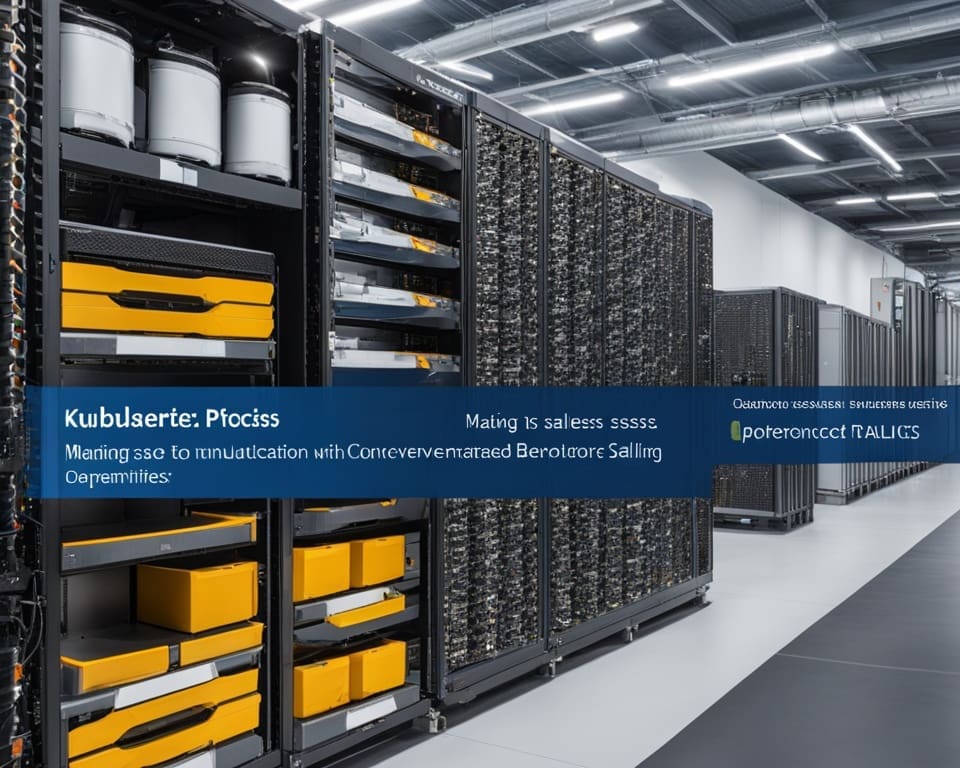Kubernetes is an incredible open-source platform, created by Google. It revolutionises the way we deploy applications by automating management, deployment, and scaling. This makes the process much simpler than before. Nowadays, its benefits are crucial. More and more companies are realising how Kubernetes can make their deployment processes better.
In the past, deployment could be a nightmare filled with downtime and tough configurations. But Kubernetes changes all that. It offers solutions to these issues and more. With features like fixing itself, scaling automatically, and balancing loads efficiently, it makes delivering applications more reliable and smooth.
When we add tools like Helm to Kubernetes, deployment gets an extra boost. This lets developers keep up application standards without a hitch. As Kubernetes gets better, embracing its full potential is key. It’s vital for developers and companies that want excellence in deploying applications.
Introduction to Kubernetes and Its Role in Application Deployment
Kubernetes has become a key player in container orchestration. It helps companies handle the challenges of today’s software development. This platform reduces technical difficulties. This lets developers spend more time creating new applications than managing the deployment.
Understanding Kubernetes as a Container Orchestration Platform
Google developed Kubernetes and opened its source in 2014. It offers a powerful way to automate managing, scaling, and deploying applications. Its design includes elements like the Control Plane, Kubelet, and Kube-proxy. They work together to make application deployment simpler and more reliable.
The Evolution of Application Deployment Practices
The way we deploy applications has changed significantly. It shifted from traditional setups to flexible, containerized methods. Kubernetes has been a major force in this shift. It helps organizations scale apps efficiently while keeping them available and high-performing. This shift highlights Kubernetes’s vital role in today’s development landscape.
The Importance of Automating Application Deployment
Using Kubernetes to automate deployment offers many benefits. It cuts down on human errors and speeds up the delivery of new products. Focusing on automation makes the deployment process better. It improves app stability and uses resources more wisely.

Key Concepts in Kubernetes
Kubernetes brings essential concepts to the forefront of its design. These parts are vital for smooth running and easy app handling. With elements like Pods and Services, Kubernetes improves deployment and manages resources well.
Pods and Their Significance in Deployment
Pods are the basic units in Kubernetes. They wrap around containers to share storage and network. This makes scaling and managing apps easier. Pods help make sure apps work the same in different places.
Services: Facilitating Communication Between Pods
Services provide reliable pod-to-pod communication. They give stable IP addresses and DNS names, making it easier to find services in a cluster. This setup helps developers keep their focus on building the app, not on network issues.
Managing Deployments with Ease
Kubernetes uses a clear model for managing deployments. This model makes deployment easier and makes apps more reliable. By using deployments and replica sets, teams can keep their apps running smoothly.
How Kubernetes Simplifies App Deployment
Kubernetes changes how we deploy apps by managing containers intelligently. It makes deploying easier, boosting efficiency and performance.
Automated Deployment and Scaling of Containers
Kubernetes automates app deployment, adjusting container numbers based on demand. This leads to better use of resources. It can quickly react to changes in user demand, making it popular among developers.
Self-Healing Capabilities Ensuring Resilience
Kubernetes can fix itself when things go wrong. If a container fails, it quickly fixes or replaces it. This keeps services running smoothly and ensures they’re always available.
Efficient Load Balancing for Increased Availability
Kubernetes spreads the workload evenly across containers. This keeps apps running smoothly under any load. It helps provide a seamless experience for users.
Rolling Updates: Keeping Applications Live During Changes
Updates can disrupt service. But Kubernetes does it differently, with no downtime. It lets apps stay online while they’re updated, making it a smart choice in fast-moving development worlds.
Kubernetes Benefits for Developers and Enterprises
Kubernetes has changed the game in application deployment, offering big wins for developers and companies. One key advantage is how it boosts developer productivity. By automating many tasks, teams can focus more on refining applications and crafting quality code. This cuts down on development time, inspiring more innovation.
It doesn’t stop at productivity. Kubernetes also makes deploying applications easier and lets you scale them as needed. This smart scaling cuts down errors and saves time. Its flexibility lets you run applications anywhere – be it cloud, on-site, or both. This adaptability helps businesses stay agile and control costs better.
Kubernetes also shines in keeping applications reliable and making recovery smoother. It restarts failed applications on its own, keeping services available and running smoothly. Features like automatic traffic balancing improve system resilience, readying them for unforeseen challenges. As cloud-based solutions grow, using Kubernetes is becoming crucial for long-term success and staying ahead in the market.









